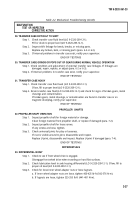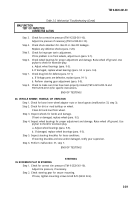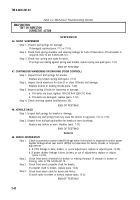TM-9-2320-361-20 - Page 118 of 1207
TM 9-2320-361-20
Table 2-2. Mechanical Troubleshooting (Contd).
MALFUNCTION
TEST OR INSPECTION
CORRECTIVE ACTION
15. EXCESSIVE EXHAUST NOISE
Step 1. Inspect turbocharger for secure mounting and exhaust leaks.
If turbocharger mountings are loose, tighten 23-27 lb-ft (31-37 N·m).
Step 2. Inspect exhaust pipes for secure connections, cracks, breaks, and excessive rust. Replace
damaged parts (chapter 3, section VIII).
Step 3. Inspect exhaust stack for secure connections, cracks, and breaks. Replace damaged parts
(chapter 3, section VIII).
Step 4. If excessive exhaust noise still exists, it may be necessary to install exhaust insulator
kit 12300664.
END OF TESTING!
16. EXHAUST FUMES IN CAB
Step 1. Inspect exhaust manifold, turbocharger, exhaust pipes, and connections for leaks.
Replace damaged parts (chapter 3, section VIII).
Step 2. Inspect exhaust manifold and turbocharger for leaks. If leaking, notify your supervisor.
END OF TESTING!
MANIFOLD HEATER SYSTEM
17. ENGINE CRANKS BUT WILL NOT START IN COLD WEATHER (FUEL SYSTEM OPERATING PROPERLY
Step 1. Check manifold heater system electrical circuit (table 2-4, malfunction 39).
Step 2. Check fuel pump supply lines and filter for leaks, bends, kinks, and restrictions. If vehicle
is equipped with alcohol evaporator, check for proper operation as required
(TM 9-2320-361-10).
Diesel fuel is flammable. Do not perform fuel system procedures
near open flame. Injury or death to personnel may result.
NOTE
●
Have drainage container ready to catch fuel.
●
During steps 3 and 4, do not confuse in-tank fuel pump pressure
with manifold heater pump pressure.
Step 3. Disconnect fuel line at fuel nozzle, energize manifold heater circuit and check to see if fuel
is discharged.
If fuel is not discharged, replace manifold heater fuel pump (para. 3-30 or 3-31).
Step 4. Check fuel nozzle for proper operation. Remove fuel return lines (para. 3-27). Energize
circuit and check to see if fuel is discharged. If fuel is not discharged, notify your
supervisor.
END OF TESTING!
2-33
Back to Top




















